Composants d'usure en carbure de tungstène are critical in the oil and gas sector. They keep drilling rigs, pumps, valves, and processing equipment running longer under extreme conditions.
For decision-makers in this industry, knowing how and why these parts are used can help in selecting the right suppliers, improving equipment performance, and cutting maintenance costs.
This article explains the unique role of tungsten carbide wear parts in pétrole et gaz, from their properties to the key applications and benefits. We will also explore how to make smart purchasing decisions for these components.
What Are Tungsten Carbide Wear Components?
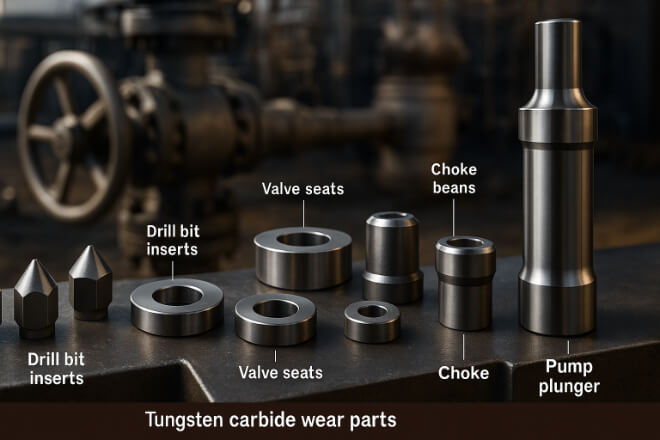
Tungsten carbide wear components are parts made from a mix of poudre de carbure de tungstène and a binder metal, usually cobalt or nickel.
Tungsten carbide is extremely hard — close to diamond on the dureté scale — while the binder gives toughness and reduces brittleness.
In the oil and gas industry, these components include:
Drill bit inserts
Valve seats and sleeves
Choke beans and nozzles
Pump plungers and liners
Wear-resistant sleeves for downhole tools
They are used where standard steel parts would quickly wear out due to sand, rock, high temperatures, and corrosive fluids.
Why Oil & Gas Needs Tungsten Carbide
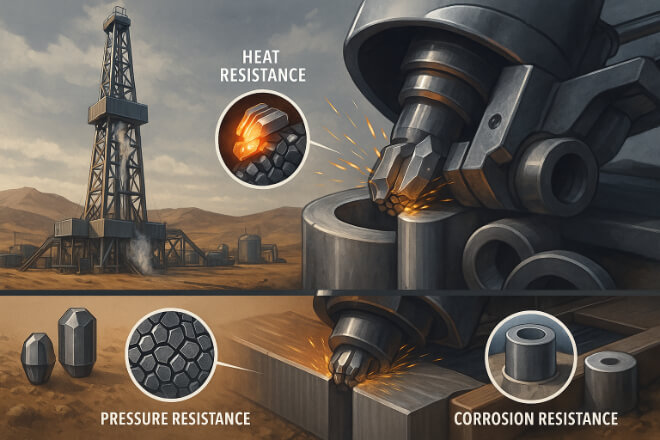
The oil and gas sector is one of the harshest working environments for machinery. Equipment faces:
Abrasive particles like sand and rock
High pressure deep underground
High temperatures in drilling and production
Corrosive fluids including saltwater, acids, and chemicals
Normal steel parts may fail quickly under these conditions. Tungsten carbide’s hardness allows it to resist wear, while its heat and corrosion resistance ensures long-term reliability.
For operators, this means:
Longer equipment life
Fewer shutdowns
Lower replacement costs
Safer operations
Properties That Make Tungsten Carbide Ideal for Oil & Gas
The reason tungsten carbide is preferred in oil and gas is because of its unique combination of properties:
| Propriété | Benefit in Oil & Gas |
|---|---|
| Dureté élevée | Resists wear from sand, rock, and metal-to-metal contact |
| Haute résistance à la compression | Withstands extreme drilling pressures |
| Résistance à la chaleur | Maintains strength at high downhole temperatures |
| Résistance à la corrosion | Works in saltwater, acidic, and chemical environments |
| Stabilité dimensionnelle | Keeps precise shape even after long use |
These qualities directly translate to higher productivity and lower maintenance costs for drilling and processing operations.
Key Applications in Oil & Gas
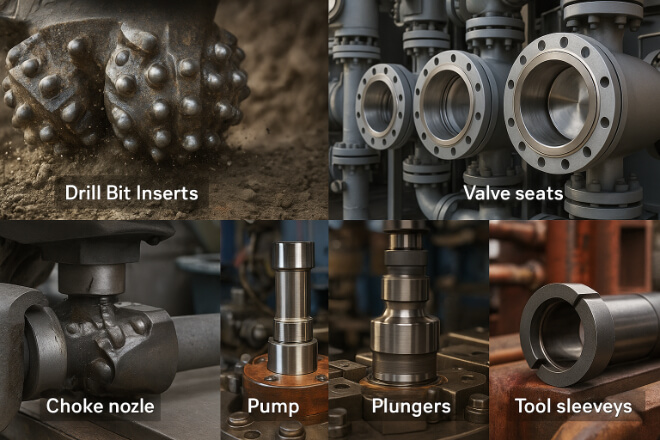
1). Drill Bit Inserts
Tungsten carbide inserts are fitted into roller cone and PDC drill bits. They crush and cut through rock while withstanding high impacts and abrasion.
Benefit: Longer drilling runs and fewer trips to replace bits.
2). Valve Seats and Sleeves
In oil and gas pipelines, tungsten carbide valve seats and sleeves control flow and seal under high pressure.
Benefit: Reliable sealing in high-pressure, abrasive, and corrosive conditions.
3). Choke Beans and Nozzles
Used in choke manifolds to control flow from wells, these parts face high-speed abrasive fluids.
Benefit: Extended service life and stable flow control.
4). Pump Plungers and Liners
High-pressure pumps in oil production use tungsten carbide plungers and liners to handle abrasive slurries.
Benefit: Reduced pump downtime and lower replacement frequency.
5). Downhole Tool Sleeves
Directional drilling tools often have tungsten carbide sleeves to prevent wear on critical surfaces.
Benefit: Protects expensive tools and reduces the risk of downhole failures.
How These Parts Are Manufactured
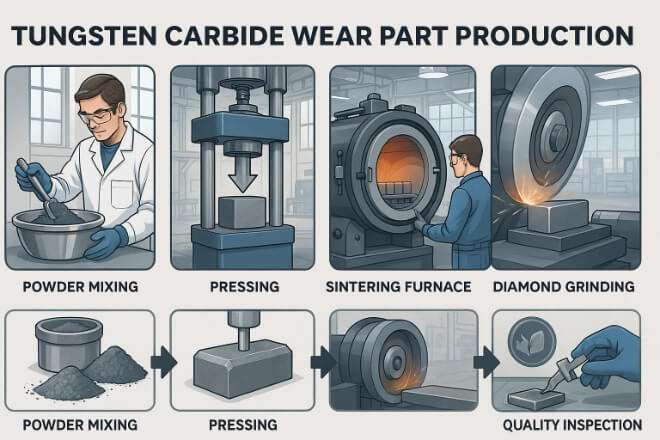
The production of tungsten carbide wear parts for oil and gas follows a precise process:
Powder Preparation – Tungsten carbide powder is mixed with a binder for toughness.
Pressing – Powder is pressed into shape using uniaxial or isostatic pressing.
Sintering – Parts are heated in a furnace to fuse the powder into a dense, solid component.
Finishing – Diamond grinding ensures precise dimensions.
Coating (Optional) – Some parts are coated for extra wear or corrosion resistance.
Choosing the Right Tungsten Carbide Components
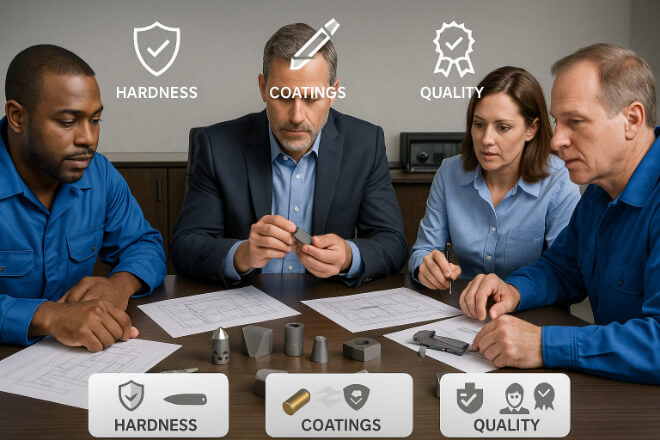
For oil and gas operations, the wrong choice can mean costly downtime. Decision-makers should consider:
1). Grade Selection
Different tungsten carbide grades balance dureté et dureté.
Harder grades last longer in abrasive conditions, while tougher grades resist impact better.
2). Coating Options
Coatings like TiN, TiC, or diamond-like carbon can further extend service life.
3). Quality Standards
Choose suppliers who follow ISO or API standards for pétrole et gaz equipment.
4). Supplier Support
Suppliers who offer technical advice can help match the right grade and design to your application.
Cost vs. Value
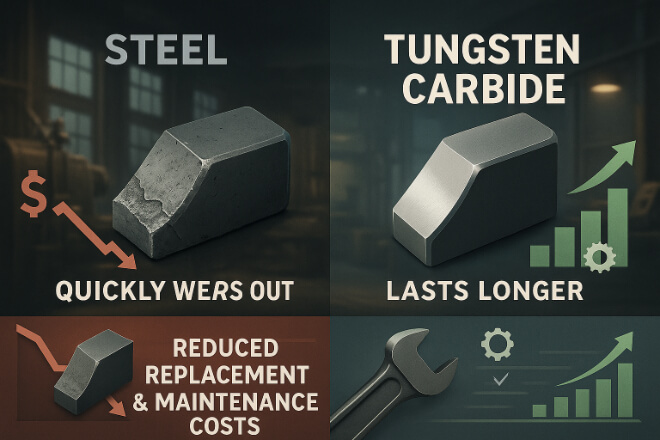
While tungsten carbide components cost more upfront than steel, they save money over time by:
Reducing replacement frequency
Cutting downtime costs
Improving safety and reliability
In high-cost pétrole et gaz operations, the return on investment is usually fast.
Conclusion
Tungsten carbide wear components are not just a luxury in oil and gas — they are essential for safe, efficient, and profitable operations.
Their unmatched hardness, strength, and resistance to heat and corrosion make them the go-to choice for drilling, pumping, and flow control applications.
For decision-makers, investing in the right tungsten carbide parts means better performance, fewer failures, and long-term savings.
Si vous souhaitez en savoir plus sur une entreprise, n'hésitez pas à Contactez-nous.
